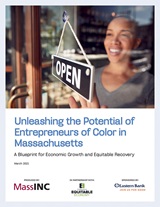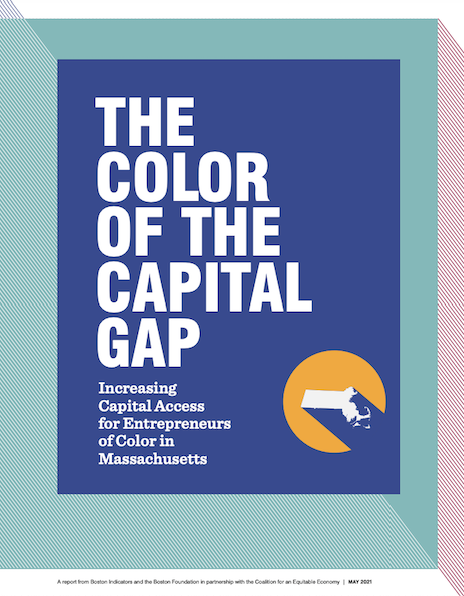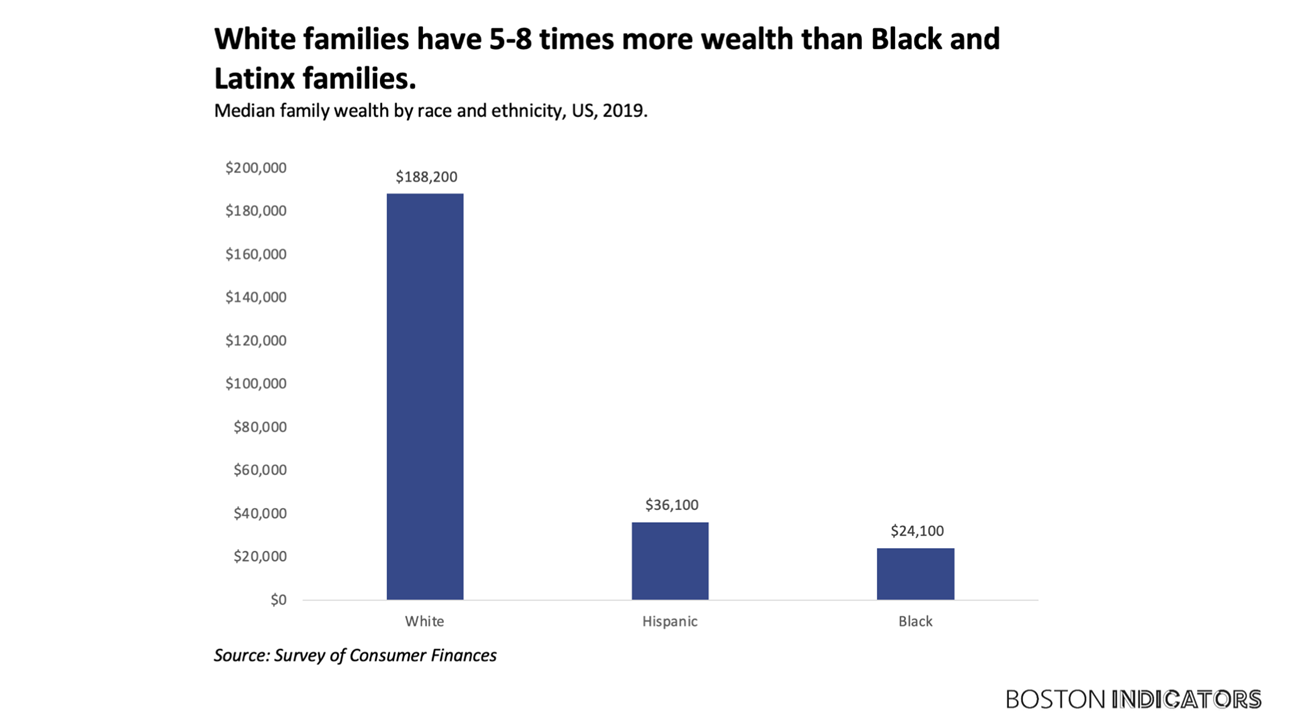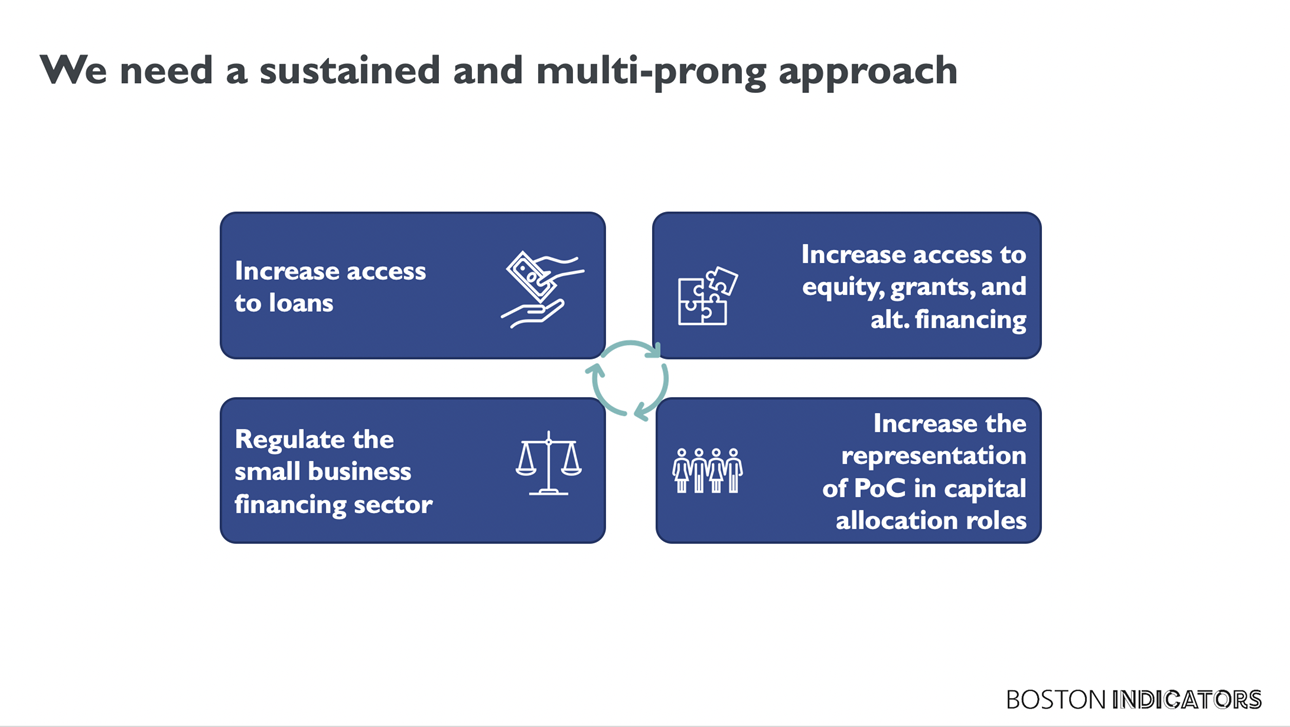As he and others pointed out, there is no lack of entrepreneurial zeal, ideas or dedication among populations of color, but the well-documented wealth gap hinders the ability of these entrepreneurs to significantly grow their businesses. That gap is driven in large part by homeownership trends and policies over generations that have made homeownership more difficult and less common for people of color. Since 98 percent of small business capital is in the form of loans backed by home value or personal wealth, it follows that the wealth gap is mirrored in the capital gap. And it is aggravated by other lingering forms of individual and institutional discrimination.
Irene Li, owner of Boston restaurant Mei Mei, brought the small business landscape to life as she shared her personal story of starting out with a food truck in 2012 followed by launching the restaurant in 2013. Because food trucks were new to Boston 10 years ago, she couldn’t get support from banks and had to rely on financial support from her family and extended network. She also works with Commonwealth Kitchen and sees the glaring lack of access to capital among the many entrepreneurs using the facilities there. People starting small food-based businesses have amazing cooking skills, a lifetime of restaurant learning, or a brilliant packaged-food idea, but typically no steady relationship with an accountant or even a bank. “Even with tons of experience,” she said, “it’s not the kind that matters to a lender.”
For those tuning in to the forum, “all this may be like hearing ‘water is wet,” said Matt Brewster, co-author of the report and, through his role as Principal at P2 Advisors, a consultant to the Coalition for an Equitable Economy. The number crunching sets the stage, he noted, but input from on-the-ground practitioners like Li is integral to framing policy recommendations, which he presented next.
Proposed action items are explained in detail in the report and supported with case studies from other regions of the country. They fall into four main buckets:
- Increase access to small business loans
- Increase access to equity, grants and alternative financing structures
- Regulate the small business financing sector
- Increase the representation of people of color in capital allocation roles
LISC Boston Executive Director Karen Kelleher and Foundation for Business Equity Executive Director Glynn Lloyd offered a response on behalf of the Coalition for an Equitable Economy. In short: Yes. We need more capital and we need implementation of the action items asap.
Corean Reynolds, Boston Foundation Program Officer, Economic Development, moderated a panel discussion among three local leaders working on business equity and advancement. Lawrence Andrews, President & CEO,
Massachusetts Growth Capital Corporation; Nia Evans, Executive Director,
Boston Ujima Project; and Greg Shell, Managing Director,
Bain Capital Double Impact talked about their respective organizations’ approaches and where the policy proposals would support and unite their work.
All were glad to see the report did not shy away from the role of structural racial discrimination in the current situation. As Andrews put it: “If you read this report and you’re not uncomfortable, there’s something wrong.” Shell agreed that a robust examination of the status quo was in order. While our economy seems strong, it is “crisis-prone and debt laden, so saying it is working well is ill-founded. The only way to really grow is to push growth out to the edges.”
There was heart for the proposal of a state bank, modeled after the Bank of North Dakota, which had been founded by farmers to serve their unmet needs in 1919 and had buffered them through many hard times since. “We want that for us,” said Evans: “Owned by the state—in other words, us—and accountable to us, not to shareholders. There’s a difference between generating returns and maximizing profits, and being committed to the former allows for flexibility that will serve real people.” Andrews agreed that was a good long-term solution but did not want to let current banks in the state off the hook from investing their dollars short term.
Shell eloquently pointed out “just how activist the U.S. government has been in policies to produce wealth in the middle class, from the Homestead Act to the G.I. Bill and beyond.” So there is precedence for targeted policies like those the report suggests. It’s just that in the past they have been targeted away from people of color. Shell said, “Those policies engineered the economic situation we have. The question is: Should we perpetuate what we’ve got? Clearly no.”
All agreed that working together across organizations and rallying personal relationships to support the cause were essential. “It’s not a problem of picking among the potential tools,” said Shell, “but getting over doubt that the goal can be reached. We need to get over the inertia of that doubt.”




